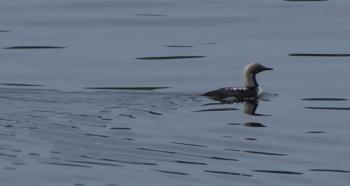Rare Loon Makes Boothbay Harbor Appearance
Loons are among Maine’s beloved birds. But many people don’t realize that there are several species of loons, in addition to the most familiar, the common loon, that we see and hear each summer on Maine lakes. Worldwide, there are currently five recognized species of loons. All five are found in the northern hemisphere, breeding in Arctic and Boreal regions, though the common loon is the only one that nests as far south as the northern part of the lower 48.
Along with common loon, there are confirmed records of three of the other loon species here in Maine. The red-throated loon occurs in relatively small numbers along the coast throughout the winter. The yellow-billed loon has definitively occurred only a single time, although there is a second unconfirmed report. Either way, it is exceptionally rare here. The Pacific loon is also a rarity, but there are reports of one or two every year. Most confirmed records have come from the southern Maine coast, often in winter.
That’s why it was a wonderful surprise on Oct. 11 when a crew of birders heading out on a popular commercial whale watching vessel to look for seabirds out of Boothbay Harbor spotted a Pacific loon, right there in the harbor. Making it particularly memorable was the fact that the bird was still largely in its beautiful breeding plumage, making it much easier to identify compared to when this species is in its winter plumage.
Pacific loons breed from coastal Siberia eastward across Alaska and northern Canada to northern Quebec. The closest known breeding areas to Maine are along the shores of James Bay and Hudson Bay about 500 miles away. As the name implies, the bulk of the population of the Pacific loon winters along the Pacific coast of North America, as far south as Mexico’s Baja Peninsula. However, a sprinkling of these birds is seen annually along the Atlantic Coast, with occasional records as far south as Florida and along the Gulf Coast to Texas.
Here in Maine, Pacific loons have been seen at the same locations over multiple years. Bald Head Cliff in York, Biddeford Pool, Pine Point in Scarborough, and Two Lights State Park in Cape Elizabeth have records of the species spanning multiple years, sometimes over decades.
One interpretation of this pattern is that the easternmost breeding populations of Pacific loons (or at least some portion of them) now regularly winter along the Atlantic Coast. So rather than think of the rare Pacific loon sighting like the one this week in Boothbay Harbor as just an oddball, off-course vagrant, we may want to ponder such birds as regular migrants to our region but just in very small numbers. Until the migratory routes of some of these birds are tracked, though, we will probably not know for sure whether this is true.
In the meantime, maybe you, like us, will scrutinize every loon you see just in case you are one of the lucky ones to spot a Pacific loon here in Maine.
Jeffrey V. Wells, Ph.D., is a Fellow of the Cornell Lab of Ornithology and Vice President of Boreal Conservation for National Audubon. Dr. Wells is one of the nation's leading bird experts and conservation biologists and author of the “Birder’s Conservation Handbook.” His grandfather, the late John Chase, was a columnist for the Boothbay Register for many years. Allison Childs Wells, formerly of the Cornell Lab of Ornithology, is a senior director at the Natural Resources Council of Maine, a nonprofit membership organization working statewide to protect the nature of Maine. Both are widely published natural history writers and are the authors of the popular books, “Maine’s Favorite Birds” (Tilbury House) and “Birds of Aruba, Bonaire, and Curaçao: A Site and Field Guide,” (Cornell University Press).































